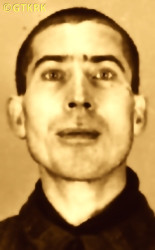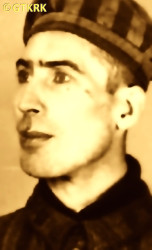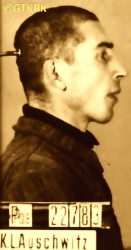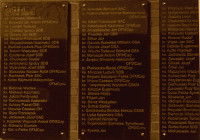Roman Catholic
St Sigismund parish
05-507 Słomczyn
85 Wiślana Str.
Konstancin deanery
Warsaw archdiocese, Poland
full list:
displayClick to display full list

searchClick to search full list by categories
wyświetlKliknij by wyświetlić pełną listę po polsku

szukajKliknij by przeszukać listę wg kategorii po polsku

Martyrology of the clergy — Poland
XX century (1914 – 1989)
personal data
surname
KALCZUK
forename(s)
Eugene (pl. Eugeniusz)
function
presbiter (i.e. iereus)
creed
Eastern Orthodox Church ORmore on
en.wikipedia.org
[access: 2014.09.21]
diocese / province
Warsaw‐Chełm OR eparchy (Polish Autocephalous Orthodox Church PAOC)
date and place
of death
08.02.1942

KL Auschwitzconcentration camp
today: Oświęcim, Oświęcim gm., Oświęcim pov., Lesser Poland voiv., Poland
more on
en.wikipedia.org
[access: 2022.01.09]
details of death
On 10.03.1928 appointed the new parish priest of Listwin near Dubno in Volyn. However, did not take over the parish because for some reason was not ordained (cheirotonia) a priest and on c. 14.07.1928 the appointment was withdrawn.
Twice — on 23.08.1932 and 20.08.1933 — arrested, prob. by Polish authorities, for unknown reasons.
After German and Russian invasion of Poland in 09.1939 and start of the World War II, after start of German occupation, found himself in the German–occupied entity, called the General Governorate (his last known parish where ministered, i.e. Hajnówka, was under Russian occupation).
Arrested by the Germans in unknown circumstances.
Prob. held in Lublin Castle prison.
From there on c. 20.11.1941 transported to KL Auschwitz concentration camp.
There perished.
prisoner camp's numbers
22783Click to display source page (KL AuschwitzClick to display the description)
cause of death
extermination: exhaustion and starvation
perpetrators
Germans
sites and events
KL AuschwitzClick to display the description, Regierungsbezirk KattowitzClick to display the description, Lublin (Castle)Click to display the description, GeneralgouvernementClick to display the description, Ribbentrop‐MolotovClick to display the description
date and place
of birth
07.07.1902

Dermantoday: Derman Persha and Derman Druha, Mizoch hrom., Rivne rai., Rivne obl., Ukraine
more on
uk.wikipedia.org
[access: 2022.08.05]
presbyter (holy orders)
ordination
09.08.1936

positions held
1938 – 02.05.1939
administrator — Hajnówkatoday: Hajnówka gm., Hajnówka pov., Podlaskie voiv., Poland
more on
en.wikipedia.org
[access: 2024.03.15] ⋄ Kazan Icon of the Mother of God RC chapel ⋄ Dubinytoday: Hajnówka gm., Hajnówka pov., Podlaskie voiv., Poland
more on
en.wikipedia.org
[access: 2024.03.15], Assumption of the Blessed Virgin Mary RC parish — acting („ad interim”)
c. 1938
resident — Jabłecznatoday: Sławatycze gm., Biała Podlaska pov., Lublin voiv., Poland
more on
en.wikipedia.org
[access: 2021.12.18] ⋄ St Onuphrius OR monastery (stavropegial)
05.11.1936 – c. 09.07.1938
parish priest — Holatoday: Stary Brus gm., Włodawa pov., Lublin voiv., Poland
more on
en.wikipedia.org
[access: 2022.06.13] ⋄ OR chapel ⋄ St Paraskeva OR parish — initially assistant to the parish priest; On 09.07.1938 the house of prayer (chapel) was demolished during the so‐called „polonization and revindication action” carried out by the Polish authorities in order to „limit the influence of the Orthodox Church”
24.09.1936
parish priest — Koretstoday: Korets urban hrom., Rivne rai., Rivne obl., Ukraine
more on
en.wikipedia.org
[access: 2021.12.19] ⋄ St Nicholas the Wonderworker OR parish ⋄ Rivne 3rd distr.Orthodox deanery name
today: Rivne rai., Rivne obl., Ukraine
more on
en.wikipedia.org
[access: 2021.09.17] OR deanery
from 21.08.1936
curatus/rector/expositus — Kopytkovetoday: Zdolbuniv hrom., Rivne rai., Rivne obl., Ukraine
more on
uk.wikipedia.org
[access: 2024.03.15] ⋄ Exaltation of the Holy Cross OR church ⋄ Ivachkivtoday: Zdolbuniv hrom., Rivne rai., Rivne obl., Ukraine
more on
uk.wikipedia.org
[access: 2023.08.19], Nativity of the Blessed Virgin Mary OR parish — assistant to the parish priest, appointed on 11.12.1935
09.08.1936
presbiter (Eng. priest, i.e. iereus) — Polish Autocephalous Orthodox Church PACP — priesthood cheirotonia, i.e. ordination, on 26.07.1936 preceded by deacon cheirotonia
till 1926
student — Kremenetstoday: Kremenets urban hrom., Kremenets rai., Ternopil obl., Ukraine
more on
en.wikipedia.org
[access: 2020.10.18] ⋄ philosophy and theology, Orthodox Theological Seminary
others related
in death
MICHAŁOWSKIClick to display biography John
sites and events
descriptions
KL Auschwitz: German Germ. Konzentrationslager (Eng. concentration camp) KL and Germ. Vernichtungslager (Eng. extermination camp) VL Auschwitz was set up by Germans around 27.01.1940 n. Oświęcim, on the German territory (initially in Germ. Provinz Schlesien — Silesia Province; and from 1941 Germ. Provinz Oberschlesien — Upper Silesia Province). Initially mainly Poles were interned. From 1942 it became the centre for holocaust of European Jews. Part of the KL Auschwitz concentration camps’ complex was Germ. Vernichtungslager (Eng. extermination camp) VL Auschwitz II Birkenau, located not far away from the main camp. There Germans murdered likely in excess of million people, mainly Jews, in gas chambers. In KL Auschwitz alone, the Germans murdered c. 30,000 prisoners by lethal injection. Until 1941, people were killed by intravenous injections of concentrated hydrogen peroxide, ether, hydrogen peroxide, or gasoline. Later, an intracardiac injection was used — with a needle about 10 cm long — of 10‐15 ml of a 30% solution of phenol C6H5OH (acquired from the German concern IG Farben, or more precisely from its subsidiary Bayer, and still used by Bayer AG, among others, for the production of aspirin), which killed within 15 seconds. Altogether In excess of 400 priests and religious went through the KL Auschwitz, c. 40% of which were murdered (mainly Poles). (more on: en.auschwitz.org.plClick to attempt to display webpage
[access: 2012.11.23], www.meczennicy.pelplin.plClick to attempt to display webpage
[access: 2013.07.06])
Regierungsbezirk Kattowitz: After the Polish defeat in the 09.1939 campaign, which was the result of the Ribbentrop‐Molotov Pact and constituted the first stage of World War II, and the beginning of German occupation in part of Poland (in the other, eastern part of Poland, the Russian occupation began), the Germans divided the occupied Polish territory into five main regions (and a few smaller). The largest one was transformed into Germ. Generalgouvernement (Eng. General Governorate), intended exclusively for Poles and Jews and constituting part of the so‐called Germ. Großdeutschland (Eng. Greater Germany). From two separate new provinces were created. The two remaining were incorporated into existing German provinces. One of those was Polish Upper Silesia, which on 08.09.1939, by decree of the German leader Adolf Hitler (formally came into force on 26.10.1939), was incorporated into Germany as the Germ. Regierungsbezirk Kattowitz (Eng. Katowice Regency) and became part of the Germ. Provinz Schlesien (Eng. Province of Silesia) based in Wrocław. On 01.04.1940, the Germ. Regierungsbezirk Kattowitz was enlarged by several pre‐war German counties, and on 18.01.1941, a new German province was created, the Germ. Provinz Oberschlesien (Eng. Province of Upper Silesia), which, apart from the Germ. Regierungsbezirk Kattowitz, also included the Opole region. From 26.10.1939, when the regency was established, the law of the German state was in force there, the same as in Berlin. The main axis of the policy of the new regency, the territory of which the Germans recognized as the Germ. „Ursprünglich Deutsche” (Eng. „natively German”), despite the fact only 6% of its pre–war Polish part were Germans, was Germ. „Entpolonisierung” (Eng. „Depolonisation”), i.e. forced Germanization. The main mechanism was the introduction of the Germ. Deutsche Volksliste DVL, a German nationality list that was supposed to specify the national affiliation of the inhabitants of the region. The largest group marked in the compulsory registrations was Group 3, people who identified themselves as „Silesians” (in 1943 about 41%), and people remaining outside the DVL (about 36%). The latter group was intended to be deported to the Germ. Generalgouvernement (which did not happen en masse because German industry needed slave labor). Group 3, considered by the Germans as capable of Germanization, was subject to certain legal restrictions, and was subject to, among others, to conscription into the German Wehrmacht army. Children could only learn in German. A policy of terror was pursued against the Polish population. There was a special police court, controlled by the Germ. Geheime Staatspolizei (Eng. Secret State Police), i.e. the Gestapo, before which c. 4,000‐5,000 people were detained. For the years 1942‐1945 over 2,000 of them were verified, of which 1,890 were sentenced to death, including 286 in public executions. Thousands of people were murdered during the so‐called «Intelligenzaktion Schlesien», including 300‐650 Polish teachers and c. 61 Polish Catholic priests. The regency hosted a German concentration and extermination camp KL Auschwitz, where the Germans imprisoned c. 1,100,000 Jews (murdering c.1,000,000, i.e. c. 90% of them) and c. 140,000 Poles (murdering c. 70,000, i.e. c. 50% of them). After the end of hostilities of World War II, the overseer of this province, the Germ. Reichsstatthalter (Eng. Reich Governor) and the Germ. Gauleiter (Eng. district head) of the German National Socialist Party, Fritz Brecht, committed suicide. (more on: en.wikipedia.orgClick to attempt to display webpage
[access: 2024.06.24])
Lublin (Castle): During World War II, the Germ. Gefängnis der Sicherheitspolizei und des Sicherheitsdienst Lublin (Eng. Police and Security Service SD Prison), through which c. 40,000‐80,000 Poles passed during the German occupation, mostly members of Polish clandestine independence organizations (part of the Polish Clandestine State), before being sent by the Germans to concentration camps. The inmates were held in inhumane conditions, in overcrowded cells — up to 3,000 were held at one time in the prison designed for 700 people — where they were starved, harassed, and disease was rampant. During interrogations were tortured. Many were murdered — the prison housed the genocidal Germ. Sondergericht (Eng. special court), which issued serial death sentences after a trial lasting several minutes. C. 2,200 perished during the investigation or in the prison; 4,500 were murdered in secret executions in the vicinity of Lublin. When the Russians were fast approached Lublin in 08.1944, c. 1,500 prisoners were sent to the KL Lublin concentration camp, where were murdered, and on 22.07.1944, after a few hours prior to escape, c. 300 remaining were murdered in the prison itself. After the expulsion of the Germans in 1944, the prison was first run by Russians, then UB, the Polish branch of the Russian NKVD, and 32,000‐33,000 soldiers of the Home Army AK, part of the Polish Clandestine State, and the National Armed Forces NSZ, fighting against the Russian occupation, were detained there (in similar conditions to the Germans — in 04.1945 c. 8,000 people were held in the prison) and tortured. C. 515 were sentenced to death and 333 were murdered. The prison began to be liquidated in 02.1954. (more on: en.wikipedia.orgClick to attempt to display webpage
[access: 2015.09.30])
Generalgouvernement: After the Polish defeat in the 09.1939 campaign, which was the result of the Ribbentrop‐Molotov Pact and constituted the first stage of World War II, and the beginning of German occupation in part of Poland (in the other, eastern part of Poland, the Russian occupation began), the Germans divided the occupied Polish territory into five main regions. In two of them new German provinces were created, two other were incorporated into other provinces. However, the fifth part was treated separately, and in a political sense it was supposed to recreate the German idea from 1915 (during World War I, after the defeat of the Russians in the Battle of Gorlice in 05.1915) of creating a Polish enclave within Germany. Illegal in the sense of international law, i.e. Hague Convention, and public law, managed by the Germans according to separate laws — especially established for the Polish Germ. Untermenschen (Eng. subhumans) — till the Russian offensive in 1945 it constituted part of the Germ. Großdeutschland (Eng. Greater Germany). Till 31.07.1940 formally called Germ. Generalgouvernement für die besetzten polnischen Gebiete (Eng. General Government for the occupied Polish lands) — later simply Germ. Generalgouvernement (Eng. General Governorate), as in the years 1915‐1918. From 07.1941, i.e. after the German attack on 22.06.1941 against the erstwhile ally, the Russians, it also included the Galicia district, i.e. the Polish pre‐war south‐eastern voivodeships. A special criminal law was enacted and applied to Poles and Jews, allowing for the arbitrary administration of the death penalty regardless of the age of the „perpetrator”, and sanctioning the use of collective responsibility. After the end of the military conflict of the World War UU, the government of the Germ. Generalgouvernement was recognized as a criminal organization, and its leader, governor Hans Frank, guilty of war crimes and crimes against humanity and executed. (more on: en.wikipedia.orgClick to attempt to display webpage
[access: 2024.12.13])
Ribbentrop‐Molotov: Genocidal Russian‐German alliance pact between Russian leader Joseph Stalin and German leader Adolf Hitler signed on 23.08.1939 in Moscow by respective foreign ministers, Mr. Vyacheslav Molotov for Russia and Joachim von Ribbentrop for Germany. The pact sanctioned and was the direct cause of joint Russian and German invasion of Poland and the outbreak of the World War II in 09.1939. In a political sense, the pact was an attempt to restore the status quo ante before 1914, with one exception, namely the „commercial” exchange of the so‐called „Kingdom of Poland”, which in 1914 was part of the Russian Empire, fore Eastern Galicia (today's western Ukraine), in 1914 belonging to the Austro‐Hungarian Empire. Galicia, including Lviv, was to be taken over by the Russians, the „Kingdom of Poland” — under the name of the General Governorate — Germany. The resultant „war was one of the greatest calamities and dramas of humanity in history, for two atheistic and anti‐Christian ideologies — national and international socialism — rejected God and His fifth Decalogue commandment: Thou shall not kill!” (Abp Stanislav Gądecki, 01.09.2019). The decisions taken — backed up by the betrayal of the formal allies of Poland, France and Germany, which on 12.09.1939, at a joint conference in Abbeville, decided not to provide aid to attacked Poland and not to take military action against Germany (a clear breach of treaty obligations with Poland) — were on 28.09.1939 slightly altered and made more precise when a treaty on „German‐Russian boundaries and friendship” was agreed by the same murderous signatories. One of its findings was establishment of spheres of influence in Central and Eastern Europe and in consequence IV partition of Poland. In one of its secret annexes agreed, that: „the Signatories will not tolerate on its respective territories any Polish propaganda that affects the territory of the other Side. On their respective territories they will suppress all such propaganda and inform each other of the measures taken to accomplish it”. The agreements resulted in a series of meeting between two genocidal organization representing both sides — German Gestapo and Russian NKVD when coordination of efforts to exterminate Polish intelligentsia and Polish leading classes (in Germany called «Intelligenzaktion», in Russia took the form of Katyń massacres) where discussed. Resulted in deaths of hundreds of thousands of Polish intelligentsia, including thousands of priests presented here, and tens of millions of ordinary people,. The results of this Russian‐German pact lasted till 1989 and are still in evidence even today. (more on: en.wikipedia.orgClick to attempt to display webpage
[access: 2015.09.30])
sources
personal:
pl.auschwitz.orgClick to attempt to display webpage
[access: 2012.11.23], www.harmeze.franciszkanie.plClick to attempt to display webpage
[access: 2012.12.28], bazhum.muzhp.plClick to attempt to display webpage
[access: 2020.02.15]
bibliographical:
„Hierachy, clergy and employees of the Orthodox Church in the 19th‐21st centuries within the borders of the Second Polish Republic and post–war Poland”, Fr Gregory Sosna, M. Antonine Troc-Sosna, Warsaw–Bielsk Podlaski 2017
original images:
auschwitz.orgClick to attempt to display webpage
[access: 2015.03.01], auschwitz.orgClick to attempt to display webpage
[access: 2015.03.01], auschwitz.orgClick to attempt to display webpage
[access: 2015.03.01], www.harmeze.franciszkanie.plClick to attempt to display webpage
[access: 2014.03.21]
LETTER to CUSTODIAN/ADMINISTRATOR
If you have an Email client on your communicator/computer — such as Mozilla Thunderbird, Windows Mail or Microsoft Outlook, described at WikipediaPatrz:
en.wikipedia.org, among others — try the link below, please:
LETTER to CUSTODIAN/ADMINISTRATORClick and try to call your own Email client
If however you do not run such a client or the above link is not active please send an email to the Custodian/Administrator using your account — in your customary email/correspondence engine — at the following address:

giving the following as the subject:
MARTYROLOGY: KALCZUK Eugene
To return to the biography press below:
 Click to return to biography
Click to return to biography











